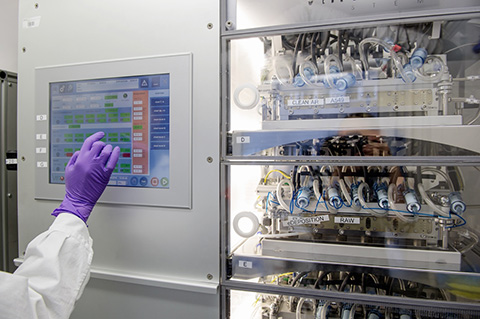'Clean-burning' Fuels May be Worse for Your Lungs

U.S. Navy/Journalist Seaman Marc Rockwell-Pate
(Inside Science) -- Government policies encourage people to use supposedly "clean" fuels, such as processed wooden pellets for heating homes and diesel for powering ships. But these measures may do more harm than good for human health, according to recent research. In a series of experiments with human lung cells, researchers found that low-emission fuels can be highly dangerous because of the particular types of particles they contain.
Although the endorsed fuel types do reduce the overall amount of particles produced by combustion, that's not the only factor that needs to be considered, said Ralf Zimmermann, a physical and analytical chemist at the University of Rostock and Helmholtz Zentrum München in Germany. "It's not just, 'Oh, I've reduced my particles by a factor of eight; now it's eight times better.'"
To see how exhaust fumes really impact health, Zimmermann and his colleagues constructed an artificial lung by growing human lung cells on a nutrient broth. They burned various fuels using different kinds of engines, then pumped the exhaust directly onto the cells.
Fake lungs, real exhaust
The first set of experiments focused on ship engines, which usually burn a cheap petroleum product known as heavy fuel. Heavy fuel combustion creates thick clouds of exhaust, which the researchers planned to use as a model system for a highly toxic fuel. Ship engines can also burn diesel fuel, which is thought to be safer because it produces less particulate matter. To comply with regulations on sulfur emissions, many ships switch from heavy fuel to diesel when they enter "emission control areas" near certain populated coastlines, Zimmermann said.
When the researchers pumped both kinds of ship exhaust into artificial lungs, the cells showed clear signs of stress, ramping up production of various proteins involved in inflammation. But to everyone's surprise, diesel exhaust triggered an even stronger response than heavy fuel. The cells in diesel fumes may have been suffering from exposure to soot, which is less abundant in heavy fuel exhaust than in diesel, Zimmermann said. He and his colleagues published the findings in two papers in PLOS ONE.
It's too soon to conclude that diesel exhaust is worse for your health in general, notes Michael Hays, a physical scientist with the U.S. Environmental Protection Agency, who wasn't involved in the project, but has recommended it for a research award offered by the oil and gas company Eni. The artificial lung experiments only looked at lung cells, and more research is needed to assess long-term impacts and the role of other systems like the heart. But, he said, the findings are enough to cast doubt on the wisdom of switching to diesel in harbors.
"Switching may not, in all cases, be something that applies a benefit from a public health perspective," he said. "We need to look at that closely now."
Many ways to be toxic
More recently, Zimmermann and his colleagues have used their artificial lungs to test a suite of other fuels and engines. The diesel ship exhaust remained the worst, but each type of exhaust had its own downsides. For example, preliminary findings show that while ethanol produces fewer solid particles than gasoline, it creates toxic gases such as formaldehyde and acetaldehyde, according to Zimmermann.
Some of the most surprising results came from pellet burners, devices that heat homes by burning small, processed chunks of wood. Pellet burners burn hotter than traditional wood stoves, resulting in more complete combustion and less smoke. But the high temperatures also release more metals such as zinc, and these metals seem to be especially toxic. In Zimmerman's experiments, which he presented this week at the American Geophysical Union meeting in San Francisco, cells reacted more strongly to pellet fumes than to regular wood smoke.
"The pellet burner, which is supposedly very good, turned out to have more effects -- and a lot of them -- because the particles are more harsh," Zimmermann said.
Zimmermann's team isn't the first to expose lung cells to combustion products, but their setup is especially realistic, according to Markus Kalberer, an atmospheric chemist at the University of Cambridge in England. Like Hays, Kalberer was not involved in the project, but he wrote a letter recommending it for the Eni award.
In the past, Kalberer said, researchers have studied emissions by collecting particles on a filter, flushing them out with solvents, and then dripping the pollutants onto cells from a pipette. But many compounds in exhaust fumes are highly reactive, and the more you process them, the more likely they are to turn into something else before reaching the cells. That makes it hard to know whether cells' reactions have anything to do with real-world pollution.
"What Ralf did, really, is get around all that, and mimic very closely what's happening in the human lung," Kalberer said. Moreover, he said, the team used an impressive suite of techniques to analyze the cells, gaining detailed information about metabolism and gene activity. Most past analyses have been cruder, sometimes just looking at how many cells survive.
The surprising dangers of diesel and pellet burners highlight the need to filter exhaust, regardless of where it comes from, Zimmermann said. Scrubbers and other clean-up technologies are now standard in power plants and cars, but they are less common in ships.
"Imagine how big a ship engine is. It's an engine like a house. And this engine, with each huff, emits a huge amount of particles," Zimmermann said. "The only treatment is a chimney."


